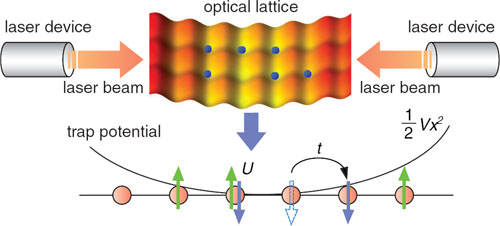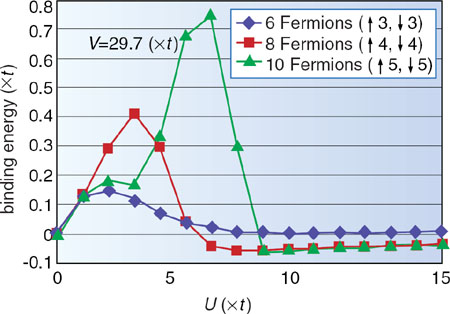Recently, material properties peculiar to nanoscale size (10-9 m) have been intensively investigated in the fields of both pure and applied physics. Especially, anomalous superconducting behavior and the mechanisms of superconductivity confined to nanoscale sizes have attracted much interest from not only fundamental but also engineering viewpoints.
On the other hand, in atomic gases, the observation of various phenomena encountered inside solid-state matter, like Bose-Einstein condensation, the superfluid transition in Fermi particles, and the superfluid-insulator transition, have been reported as experimental achievements in atomic physics research. Furthermore, it has been proven that the excellent tunability in atomic Fermi gases by means of laser beam and magnetic fields enables us to study these phenomena more systematically and easily than in solid-state matter (Fig. 10-4). This indicates that superconductivity and its properties in nanoscale sizes may be more easily understandable by examining atomic Fermi gases.
Thus, we have investigated the superfluidity mechanism of atomic Fermi gases under a situation analogous to high Tc cuprate superconductor (Fig. 10-4) with the use of the exact diagonalization method, which can calculate quantum states with the highest accuracy. To accomplish this purpose, we have developed an algorithm for the vectorization and the parallelization specific to the Earth Simulator and have succeeded in obtaining the quantum ground state of unexplored large-scale matrices within only a few minutes [1].
The present model describing the atomic Fermi gas placed on an optical lattice (Fig. 10-4) has a trap potential whose role is to gather particles around a trap center in addition to t and U which, respectively, are the kinetic energy to hop between sites and the repulsive interaction working through the single-site double occupation by different pseudo-spin particles, as seen in the standard model of a high Tc superconductor (Fig. 10-4). Our calculation determines the binding energy to judge whether the ground state is superfluid by diagonalizing the model Hamiltonian matrix. If the binding energy is positive, then a repulsive interaction works between two Fermi particles. In contrast, a negative value means that two particles interact with attractive interaction, which normally leads to superfluidity.
Throughout systematic calculations on the Earth Simulator, we concluded that the model shows superfluidity due to observations of the negative binding energy above a critical U and particle number (Fig. 10-5) [2]. Furthermore, we found that the negative binding is controllable by adjusting the trap potential [2]. These results suggest that the superconductivity confined inside nanoscale matter is tunable if the confined potential is reproducible in solid-state matter. |

